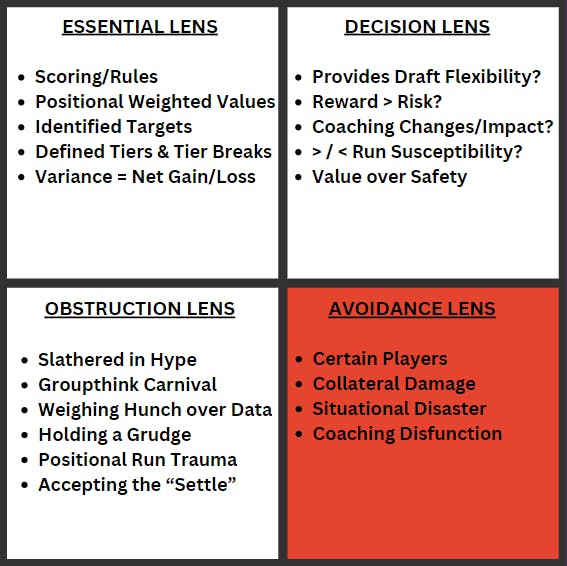Let's dispense with the obvious. I tend to view fantasy football through a psychological lens pretty much all the time. Whether it's tracking tendencies and habits of league mates, studying interactions, and diving into the nuances of strategy – the mental aspects of the game have always fascinated me more than scrutinizing data and fine-tuning projections. That said, I often look for ways to use tools that are utilized in the business world and apply them in a way that's helpful to improving or streamlining performances in fantasy football.
The Matrix
One of the business tools I've applied frequently to fantasy football is the Eisenhower Matrix. Wikipedia defines the "Eisenhower Method" by stating it utilizes the principles of importance and urgency to organize priorities and workload. Now, I've talked about this idea many times while on podcasts and social media, and I've even written an article or two covering this concept. But as with all things fantasy football related, how we approach and implement a process should adapt and evolve as we refine the application, and that's exactly the case with this matrix. An Eisenhower Matrix, when formatted for drafting purposes, is a tool that helps build the framework for a high-level blueprint and serves as a reminder to either stay the course or pivot strategically.

Essentials Lens
The Essentials Lens zeroes in on the foundational elements of your draft. Which players are on your pre-draft Wish List, which positions identify as a priority, and what impact does the scoring or format have on overall strategy or each round's selection? These are all examples of what might fill the Essentials quadrant. In its simplest form, this section is all about the key components to executing successfully and staying true to your core draft principles.
Decision Lens
The Decision Lens speaks to precisely that – contemplation and consideration. It encompasses all the crucial facets that are fluid and considerably less rigid than the quadrant associated with the Essentials Lens. It revolves around identifying variance and involves applying context, considering roster diversification, risk-reward projections, ADP, tier breaks, and what I term the "hot commodity index" (indicative of how the broader community perceives a player post-training camp). This section should be your pivot section, allowing for adjustments in strategy and addressing potential vulnerabilities pinpointed during the draft process.
Obstruction Lens
The Obstruction Lens serves as an anchor, keeping you grounded and focused. This is where vulnerabilities and potential distractions are listed. A visual reminder to avoid all the off-ramps and rabbit holes that can easily derail even the best strategies. It can range from a simple reminder to avoid getting swept up in positional runs to weighing the grudge I hold against a particular player because he's slathered in a few disappointing performances that still sting more than they should. I often emphasize the importance of self-awareness in fantasy football, and this section acts as a navigational tool, guiding me safely through the minefield of past mistakes.
Avoidance Lens
The Avoidance Lens serves as your red flag. It stands diametrically opposed to the Essentials Quadrant in terms of value, yet it remains a foundational component of the process. Certain scenarios, players, and coaching staffs can fall into this apocalyptic category due to circumstances – dreadful surrounding talent, poor QB play, a weak offensive line, or a terrible scheme-to-talent relationship. By identifying these hazards beforehand, you arm yourself with a valuable piece of the equation prior to entering a draft.
Closing
Constructing this type of matrix before a draft provides a tangible blueprint that guards you against making impulsive picks or inadvertently caving to the strategies your league-mates try to impose. It enables you to stay true to your compass and make sound decisions while highlighting potential pitfalls and poor judgments in advance. The focus invested in creating an Eisenhower Matrix also serves as a form of mental rehearsal, allowing you to visualize the strategy before you accomplish it - a type of cerebral muscle memory - setting you up to simply do it again. The act of compartmentalizing also allows you to go back and revisit the process, looking for ways to improve it going forward. This one tool has helped improve my strategy development and execution and also strengthened my adaptability during drafts.
Thanks for reading! If you want to learn more about dynasty fantasy football and the strategic nuances associated with fantasy football in general, follow me on X @Ciga_FF. Let me know your questions and how I can help.
